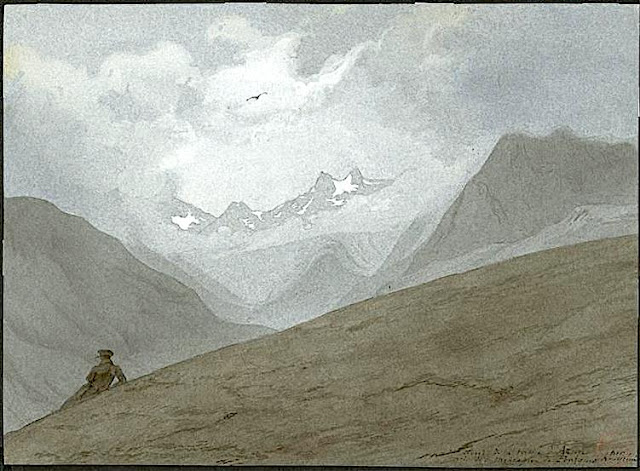JAMES WEBB (1835-1895)
Le Mont Saint-Michel (92 m - 302 ft
France (Normandie)
La montagne
Le Mont-Saint-Michel (92 m - 302 ft) est
une commune insulaire de Normandie, en France. Le Mont Saint-Michel
(d'abord appelé Mont Tombe) est constitué de leucogranite, qui s'est
solidifié à partir d'une intrusion souterraine de magma en fusion il y a
environ 525 millions d'années, pendant la période cambrienne. Il est
situé à environ un kilomètre au large de la côte nord-ouest du pays, à
l'embouchure de la rivière Couesnon près d'Avranches et a une superficie
de 100 hectares (247 acres).
L'île a tenu des fortifications
stratégiques depuis l'Antiquité. Depuis le 8ème siècle de l' ère
chrétienne, elle est le siège du monastère dont elle tire son nom. La
composition structurelle de la ville illustre la société féodale qui l'a
construite : au sommet, Dieu, l'abbaye et le monastère ; en bas, les
grandes salles ; puis magasins et logements ; et au fond, à l'extérieur
des murs, des maisons de pêcheurs et d'agriculteurs. La position de la
commune la rendait accessible à marée basse aux nombreux pèlerins de son
abbaye, mais défendable car une marée montante échouait, chassait ou
noyait les assaillants potentiels. Le Mont est resté invaincu pendant la
guerre de Cent Ans ; une petite garnison repoussa une attaque des
Anglais en 1433. Les bénéfices de sa défense naturelle ne sont pas
perdus pour Louis XI, qui transforme le Mont en prison. A partir de ce
moment là, l'abbaye fut de plus utilisée plus régulièrement comme
prison pendant toute la période monarchique. Le Mont Saint Michel est
l'un des monuments les plus reconnaissables de France, visité par plus
de 3 millions de personnes chaque année, avec sa baie il est inscrit
sur la liste du patrimoine mondial de l'UNESCO. Plus de 60 bâtiments de
la commune sont protégés au titre des "Monuments historiques".
Au
11e siècle, l'architecte italien William di Volpiano fut choisi par
Richard II, duc de Normandie, pour être l'entrepreneur de construction
de l'église du Mont Saint-Michel. Il conçoit l'église romane de
l'abbaye, plaçant audacieusement la croisée du transept au sommet du
mont. De nombreuses cryptes et chapelles souterraines ont dû être
construites pour compenser ce poids ; ceux-ci ont formé la base de la
structure ascendante de soutien que l'on peut voir aujourd'hui.
Robert
de Thorigny, grand partisan d'Henri II d'Angleterre (également duc de
Normandie), renforce la structure des bâtiments et construit la façade
principale de l'église au 12e siècle.
En 1204, Guy de Thouars, régent
de la duchesse de Bretagne, vassal du roi de France, entreprend le
siège du Mont. Après avoir incendié le village et massacré la
population, il fut obligé de battre en retraite sous les puissantes
murailles de l'abbaye. Les bâtiments et les toits ont été la proie des
flammes. Horrifié par la cruauté et les exactions de son allié breton,
Philippe Auguste offrit à l'abbé Jordan une subvention pour la
construction d'un nouvel ensemble architectural gothique qui comprenait
l'adjonction du réfectoire et du cloître.
On attribue à Charles VI
l'ajout de fortifications majeures au mont abbatial, la construction de
tours, de cours successives et le renforcement des remparts.
Depuis
2001, une communauté de moines et de moniales des Fraternités
monastiques de Jérusalem, envoyées de la maison-mère de
St-Gervais-et-St-Protais à Paris, vit en communauté sur le Mont
Saint-Michel. Ils ont remplacé les moines bénédictins revenus au Mont en
1966. Ils sont locataires du Centre des Monuments Historiques Nationaux
et ne participent pas à la gestion de l'abbaye. La communauté se réunit
quatre fois par jour pour réciter l'office liturgique dans l'abbaye
même (ou dans la crypte de Notre-Dame des Trente Cierges en hiver). De
cette manière, le bâtiment conserve sa vocation première de lieu de
prière et de chant de la gloire de Dieu. La présence de la communauté
attire de nombreux visiteurs et pèlerins qui viennent se joindre aux
différentes célébrations liturgiques.
En 2012, la communauté a
entrepris la rénovation d'une maison sur le Mont, le Logis
Saint-Abraham, qui sert de maison d'accueil pour les pèlerins en
retraite
Le peintre
James Webb (1835–1895), qui n'a
aucun rapport avec le télescope spatial du même nom, était un peintre
britannique spécialisé dans les vues et paysages marins bine qu'il vécut
toute sa vie à Chelsea, Londres ! était né dans une famille
d'artistes. Son père Archibald Webb et son frère Byron Webb étaient
également des peintres réputés. Il exposa à Londres à la Royal Academy
et au British Institute entre 1850 et 1888, et nombre de ses œuvres sont
toujours accrochées à Londres dans les collections du Victoria and
Albert Museum et de la Tate Gallery . D'autres œuvres se retrouvent dans
un grand nombre de galeries provinciales. Webb était un élève de
Clarkson Frederick Stanfield .
_________________________________________
2023 - Wandering Vertexes ....
Errant au-dessus des Sommets Silencieux...
Un blog de Francis Rousseau







%20ALPILLES,%201977%20Dessin%20a%CC%80%20l'encre%20de%20Chine%20sur%20papier-%20100x%20149,80cm%20-%20Artcuiral%20CP%20.png)






